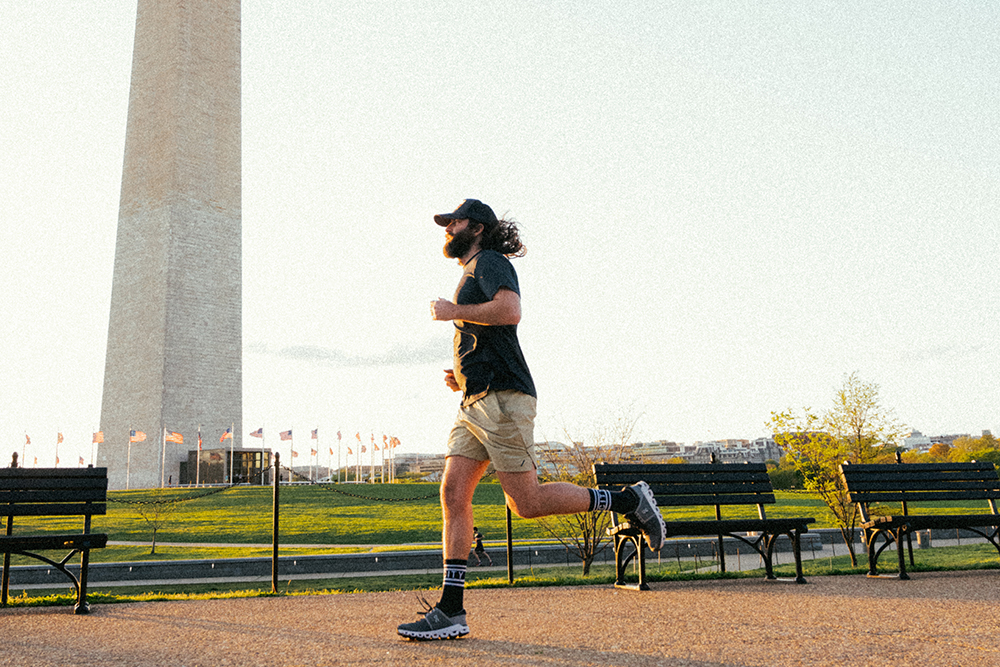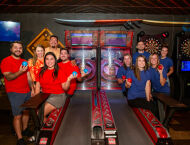Play

Outdoor Etiquette: How to Safely Stay Active
June 5, 2020 @ 10:00am
By now, we’ve all learned that Covid-19 has hindered some of our favorite ways to play, including the closure of gyms, postponement of professional sports seasons and cancellation of club sports games. Active Washingtonians are itching to get back to their fitness routines, and as restrictions begin to loosen, there seems to be a light at the end of the quarantine tunnel. However, it is still important to practice safe play as experts continue to monitor the situation. How do you best ensure the safety of yourself and others while remaining active? Do you have to wear a mask while running or bicycling outside? Will gym sessions have to remain online for the rest of the year? When can you hit the track again?
Official Guidelines
For the answers to these questions, it is best to turn to resources provided by the Centers for Disease Control and Prevention (CDC) and http://coronavirus.dc.gov for District-specific health and safety measures. Sometimes, though, government PDFs can feel overwhelming to read and hard to understand. We at District Fray decided to take the time to outline the best way for you to stay fit while maintaining social distancing rules.
According to the D.C. government’s coronavirus resource website, it is recommended to wear face coverings and maintain a safe distance from others while on walking trails and fields, or in public parks and other outdoor recreation areas. Although you are outside, you should always follow these guidelines for the health and safety of yourself and others around you. Even as the District moves to the next phase of coronavirus protocols and more public spaces reopen, it is imperative to continue to follow these basic regulations until expert officials state otherwise.
Per the CDC, it is best to visit parks and fields close to your home for recreational use. Traveling long ways may increase your exposure to the virus and the possible spread of the virus to others, as more traveling generally requires more stops along the way to your destination. In other words, you will be in closer proximity to other people and will be exposed to surfaces that may have been contaminated by the virus.
If the park or field near you is crowded, the CDC recommends planning your visit for another, less busy timeframe. If you can stay at least six feet apart from others, you are safe to enter the area. State and local authorities are in charge of opening national and local parks, and do so on a park-by-park basis. Before you go, be sure to check if the park you are visiting is open and to what degree.
The CDC recommends not participating in group activities or sports, as these generally require team members that are not from the same household. Keep washing your hands for at least 20 seconds regularly, bring hand sanitizer if you plan on going out, and wear protective face masks when visiting parks, beaches, fields or any other recreational area.
Washingtonians in Action
Carl Maynard, founder of the group Walk With Locals, has been trying to figure out how to keep his passion for exploring D.C. alive while safely following guidelines provided by the government. Walk With Locals is indefinitely on hold for in-person walks out of caution, but the group has moved online with Instagram Live, highlighting photographers and local businesses.
“We want to see the city, and it’s a really hard decision to open back up,” Maynard says of the shutdown measures. “I support the city on that, but in the meantime, we wanted to find a way to help distract people [from current events] and brighten their day.”
Maynard is also an avid runner, and has been taking precautionary measures to ensure he is following regulations provided by the CDC. Maynard has been running in less populated areas and during times that other runners are not out, per the guidelines previously mentioned. Despite social distancing laws, the running community is still able to show support for one another in little ways, according to Maynard.
More people are finding time to run, but are respectful of one another’s space during this time and give a small nod or smile when out to instill some sort of camaraderie. Maynard says that these small acts of support are more important than ever during this weird time.
“All we can do is help each other out and be supportive of one another.”
Another group that had to pump the breaks on its activities due to the virus is the November Project, originally founded by Boston runners to encourage one another to push through the cold winter months and continue their training. Now a national movement, the November Project brings people of all backgrounds and fitness levels together in an effort to hold one another accountable in their workouts and make training enjoyable.
The D.C. group regularly hosts outdoor workout activities multiple times a week, but has had to adapt to the realities of the virus. For the past several weeks, the group has moved its workouts to Zoom, allowing everyone in the group to stay safe, connected and motivated. According to local November Project leader Maria Randazzo, these at-home workouts are designed with constraints such as small living spaces in mind so that anyone can participate.
“So much of our workout design is dependent on where we are physically, whether that’s the Lincoln Memorial running stairs on Wednesdays or Meridian Hill Park running hills on Mondays,” Randazzo says. “Having to shift that thinking and framework to ‘We’re all going indoors now,’ we can’t do an exercise that requires a lot of dynamic movement because we’re now cognizant of people having neighbors or roommates. We have to be so much more creative now.”
One way the group has had to be creative is in how it connects with one another. There is now a “quarantine challenge” with over 150 people signed up to compete every Monday to have the most reps in a day of a myriad of exercises. These group challenges and Zoom calls provide the community that members are missing right now. At the end of the day, members of the November Project go to it for the camaraderie and friendship it provides, not just the workouts.
Until restrictions are lifted, the November Project will continue to host its workouts from afar. Moving forward, the group activities will have to look different. Members will have to stop themselves from immediately hugging and high-fiving each other after a good workout, and the group may have to enforce mask wearing when working out together, per the CDC guidelines. The group is confident that they will be back, but not until they are assured that it’s safe for members to engage in in-person meetups.
“We all are just trying to find as much joy as we can in the current situation,” concludes Emma Cowan-Young, another November Project leader.
For up-to-date official recommendations and restrictions on how to safely enjoy the outdoors, visit www.cdc.gov or http://coronavirus.dc.gov.
Follow Maynard on social media @carlnard and Walk With Locals @walkwithlocals for photos of D.C. and to join conversations with other locals.
Get involved with the November Project @novemberprojectdc on Instagram and @nov_project_DCA on Twitter.
Enjoy this piece? Consider becoming a member for access to our premium digital content and to get a monthly print edition delivered to your door. Support local journalism and start your membership today.







